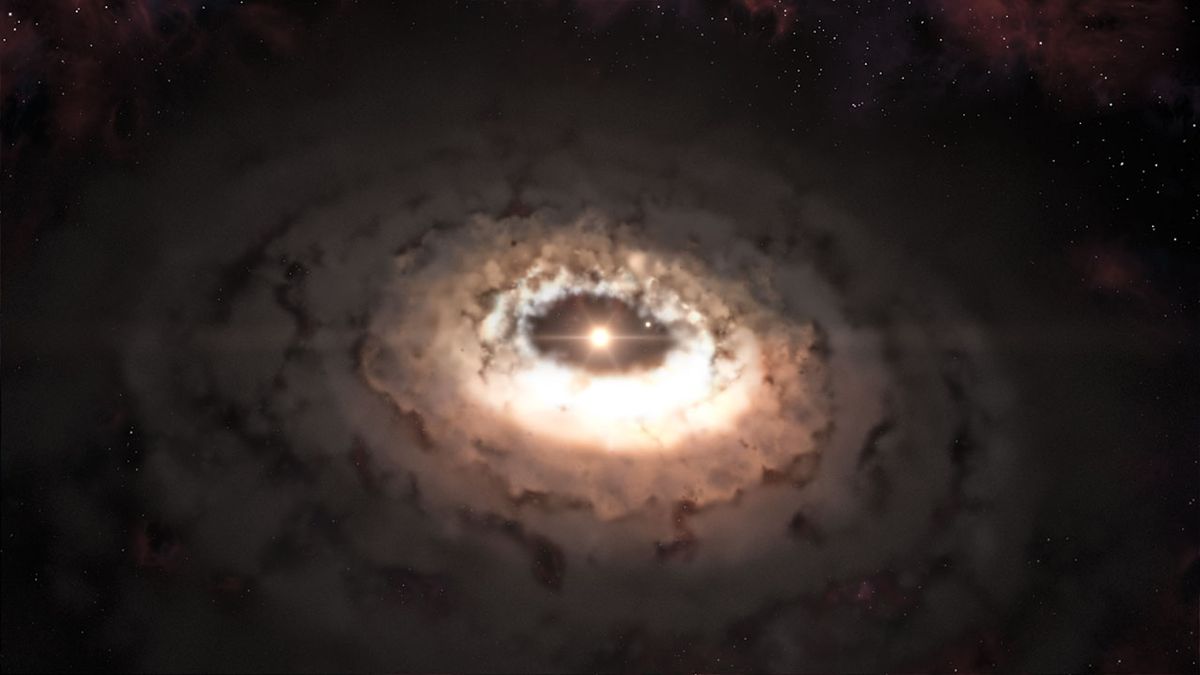Scientists have long queried how the complex molecules needed for life could have formed around the tumultuous and violent environment of the sun in its youth.
A family of meteorites called “chondrites” is theorized to have delivered the right stuff for life to Earth. But the question is, how did complex organic molecules containing elements like carbon, nitrogen, and oxygen come to be sealed in these meteorites in the first place?
New research suggests that the “hot spot” for the formation of these macromolecules, the essential building blocks of life, may be so-called “dust traps” in swirling disks of matter around infant stars. Here, intense starlight from the central young star could irradiate the accumulating ice and dust to form carbon-containing macromolecules in just decades, which is relatively rapid.
This would mean the macromolecules could already be present when larger planetesimals form planets, or they could be sealed in asteroids in the form of small pebbles. These asteroids could have then be broken down by repeated collisions in space, creating smaller bodies. Some of these could have arrived at Earth in the form of meteorites.
RELATED: ‘Building blocks of life’ discovered on Mars in 10 different rock samples
“It is incredible to discover a new crucial role of dust traps in the formation of macromolecular matter that planets may need for hosting life,” team member Paola Pinilla of the Mullard Space Science Laboratory at University College London told Space.com. “Dust traps are beneficial regions for dust particles to grow to pebbles and planetesimals, which are the building blocks of planets.”
Pinilla explained that in these regions, very small particles can be continuously recreated and replenished by ongoing destructive collisions. These tiny micron-sized grains can easily be lifted to the upper layers of the flattened cloud of star-forming material that surrounds an infant star, called a protoplanetary disk.
Once here, Pinilla said these particles can receive the right amount of irradiation from their infant star to efficiently convert these tiny icy particles into complex macromolecular matter.
Replicating the solar system’s early days in the lab
Stars like the sun are born when overdense patches form in massive clouds of interstellar gas and dust. First becoming a protostar, the infant stellar body gathers matter from what remains of its birthing cloud, piling on the mass needed to trigger the nuclear fusion of hydrogen to helium in its cores. This is the process that defines a star’s “main sequence” lifetime, which for a star around the mass of the sun will last around 10 billion years.
This young star is surrounded by a protoplanetary disk, which is material that wasn’t consumed during its creation and ascension to the main sequence. As the name suggests, it is from this material and within the disk that plants form, but it also accounts for the origin of comets and asteroids.
Our solar system went through this creation process around 4.5 billion years ago.
Previous research conducted in labs here on Earth has indicated that when these protoplanetary disks are irradiated with starlight, complex molecules of hundreds of atoms can form within them. These molecules are built mostly of carbon and are similar to black soot or graphene.
Dust traps are high-pressure locations in protoplanetary disks where the motion of molecules is slowed, and dust and ice grains can accumulate. The slower speeds in these areas can allow grains to grow and, for the most part, avoid collisions that cause fragmentation. This means they could be essential to the formation of planets.
The team wanted to know if the radiation that starlight brings to these areas could cause complex macromolecules to form, using computer modeling to test this idea. The model was based on observational data collected by the Atacama Large Millimeter/submillimeter Array (ALMA), an array of 66 radio telescopes in northern Chile.
“Our research is a unique combination of astrochemistry, observations with ALMA, laboratory work, dust evolution, and the study of meteorites from our solar system,” team member Nienke van der Marel of Leiden University said. “It’s really super cool that we can now use an observation-based model to explain how large molecules can form.”
The model revealed to the team that the creation of macromolecules in dust traps is a feasible idea.
“We had hoped for this result, of course, but it was a nice surprise that it was so obvious,” team leader Niels Ligterink of the University of Bern said. “I hope that colleagues will pay more attention to the effect of heavy radiation on complex chemical processes. Most researchers focus on relatively small organic molecules of a few dozen atoms in size, while chondrites contain mostly large macromolecules.”
“In the near future, we look forward to testing these models with more laboratory experiments and observations using powerful telescopes like the Atacama Large Millimeter Array (ALMA),” Pinilla concluded.
The team’s research was published on Tuesday (July 30) in the journal Nature Astronomy.
Originally published on Space.com.




















Discussion about this post